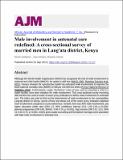Male involvement in antenatal care redefined: A cross-sectional survey of married men in Lang’ata district, Kenya.
View/
Publication Date
9/23/2013Type
Article, Journalviews
downloads
Metadata
Show full item record
Abstract/
Although the World Health Organization (WHO) has recognised the role of male involvement in maternal and child health (MNCH), its uptake is still low (WHO, 2001; Ramirez-Ferrero et al, 2012). Kenya's division for reproductive health has embraced male involvement to improve the local maternal mortality ratio (MMR) of 488 per 100 000 live births (Kenya National Bureau of Statistics, 2010). Unfortunately, single ‘facilitative’ roles of men, such as escorting a wife to a health facility, have been mistaken for male involvement. This cross-sectional survey involving 388 married men used an index of seven proxy indicators to define male involvement in antenatal care. The index was used to find out the determinants of male involvement in the cosmopolitan Lang'ata district in Kenya. Scores of four and above out of the seven proxy indicators depicted more involvement compared to scores below four. Overall, there was 40% male involvement, and higher education (odds ratio (OR) 1.5, 95% confidence interval (CI): 1.05–2.03, p <0.026), planned pregnancies (OR 0.60, 95%CI: 0.46–0.76, p <0.001), high income (OR 0.51, 0.31, 95% CI: 0.30–0.72; p <0.001, 0.023), joint couple counseling and formalised marriages were associated with high male involvement in antenatal care
Subject/
Maternal and child health; MNCH; Maternal mortality; Antenatal care; Langa'ta; Kenya
Further Details
Abstract
Publisher
Mag Online LibraryCollections
- General - GEN [367]

